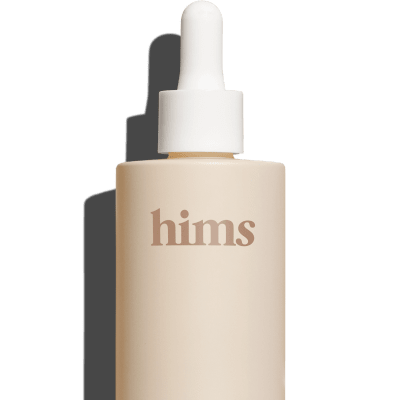Content
Over 90% of users saw increased regrowth or reduced hair loss in clinical trials
Finasteride Results Timeline: What to Expect

If you’ve searched for hair loss treatments, you’ve probably come across finasteride, an FDA-approved prescription medication. Finasteride results are backed by a number of scientific studies showing real, measurable improvements in things like hair count and density.
Still, it’s important to remember that you won’t see major changes overnight — when you take finasteride, you’re playing the long game. In general, you’ll need to wait a few months before you’ll spot any improvements in healthy hair growth or overall hair density from finasteride.
Below, we get into how long finasteride takes to work and break down the typical timeline for seeing results after starting finasteride treatment.
Content
Part of a class of medications known as 5-alpha reductase inhibitors, finasteride works by inhibiting a group of enzymes called 5-alpha-reductase and stopping your body from converting testosterone into dihydrotestosterone (DHT). DHT is the androgen hormone associated male pattern baldness, or male androgenetic alopecia, as well as problems like benign prostatic hyperplasia (BPH, or enlarged prostate).
While finasteride enters the bloodstream fairly quickly and starts reducing your levels of DHT as soon as it becomes active in the body, it generally takes three to four months of use to see noticeable results. Final results typically take around one year to become apparent.
Why does it take so long? It’s because the hair follicles on your head and body all grow as part of a four-phase hair growth cycle.
This process starts with each hair growing from the root of the hair follicle inside the scalp during the anagen phase. As the hair grows longer, it eventually pushes through your skin, allowing it to become visible. Each hair’s anagen phase, or growth phase, can last for several years.
Since it takes time for new hairs to grow from the root to a visible length, the results from finasteride aren’t immediate — even though it’s working internally. Most of the time, you’ll notice a gradual, steady improvement in your hair over the course of several months.
more hair... there's a pill for that
Finasteride Results Timeline
It’s safe to assume you’re considering finasteride because you want to see changes to your head of hair. As such, understanding the finasteride results timeline is important, so you don’t feel defeated or throw in the towel too soon.
Below, we’ll break down exactly what positive results of finasteride you can expect month by month.
Finasteride Months 1 to 3: Finasteride Starts Working
As soon as your body begins to metabolize finasteride, it will start to reduce the amount of DHT that circulates in your bloodstream. Studies show a 65 percent reduction in DHT levels just 24 hours after taking your first dose of finasteride.
This means your hair will be protected from the harmful effects of DHT almost immediately.
On average, finasteride reduces the amount of DHT in your bloodstream by around 70 percent, which is enough to significantly slow down, stop, or even reverse hair loss caused by male pattern baldness.
Keep in mind that during the first few months of using finasteride, you probably won’t notice much of a change in your hair. In fact, one-month finasteride results may have you wondering if it’s not working and if you should just ditch the medication (you shouldn’t).
Some people make the mistake of stopping finasteride too early because they think it’s not working. The hairline, crown, and general level of hair thickness will probably look exactly the same as they did before, with no significant improvements apparent (but no further deterioration either).
However, this isn’t because finasteride isn’t working properly. Instead, the lack of visible progress during the first few months is simply because your hair needs to grow before results are obvious.
During the first few months, it’s important that you continue to use finasteride daily, even if you don’t notice any results. Rest assured the medication is working properly — it’s just too early for its effects to be visible.
Finasteride Months 3 to 6: Initial Results
Most of the time, early results from finasteride start to become visible after around three to six months of daily use.
After taking finasteride for this amount of time, you may notice your hair loss has slowed down or stopped, with no further visible thinning. You may also see improvements in your hair, particularly around your hairline and crown if you were dealing with a receding hairline.
In fact, in a 2004 study, researchers found that men with male pattern hair loss displayed “significant improvement” after using finasteride for 12 weeks, or just under three months.
Because your hair needs time to grow, the results after three to six months generally won’t be your “final” results from finasteride.
Still, noticing an improvement after three to six months — even if it’s relatively modest — is generally a good sign that finasteride is starting to work for you.
Finasteride Month 12: Noticeable Results
After taking finasteride consistently for 12 months, you should see further improvements in your hair that build on your progress from months three to six.
Most studies on one-year finasteride results show significant, measurable increases in hair count, thickness, and reduction in the hair loss process after 12 months of treatment.
For example, a 1999 study found that men who used finasteride over a period of one year had a significant increase in hair count in the frontal scalp (hairline) area.
Clinical trials have also found that about 65 percent of men treated with finasteride show some degree of increased hair growth after 12 months.
Since everyone’s hair is slightly different, one-year finasteride results will vary, though you should be seeing at least improvements by this point. You may have a modest increase in hair regrowth that you can see when you brush your hair or look in the mirror, or even significant improvements that are easy to notice.
In some cases, however, taking finasteride for 12 months may not have a noticeable impact on hair thickness and growth. Rather, it will simply prevent hair loss from worsening, so you likely won’t experience further hair loss.
If you haven’t noticed any improvements in your hair volume or general hair growth after consistent use of finasteride for 12 months, it’s best to talk to your healthcare provider.
Long-Term Results From Finasteride
Finasteride continues to work after the 12-month mark, with most research showing that men who use the medication for the long term continue to see a reduction in hair loss and improved hair growth.
A study from 2003 looked at the results of finasteride over two years. The researchers found that men who used finasteride displayed a 14 percent improvement in hair count after one year of treatment, as well as a 16 percent improvement after two years.
Another study from Japan looked at the effects of finasteride on hair loss over five years of treatment. The researchers noted that 99.4 percent of men who used oral finasteride tablets during the study period showed improvements.
Put simply, the long-term effects of finasteride appear to be the same as those that occur in the short term: a reduction in hair shedding, improved hair growth, and noticeable improvements in hair thickness and scalp coverage. In other words, it’s an effective treatment for hair loss.
How to Maximize Finasteride Results
For the most part, using finasteride is simple — just take one pill every day (the best time to take finasteride is whenever you’ll remember), and then pay attention to any changes in your hairline that occur over the next few months.
However, like with other medications, there are several things you can do to maximize your results from finasteride — and reassure yourself that it really is working. For instance, you may:
Take finasteride every day. Finasteride is designed for daily use. Take your medication every day, even if you don’t notice any changes in your hairline, hair density, or thickness when you first start using it. Skipping finasteride doses or only using the medication occasionally may reduce its effectiveness and compromise your results.
Use finasteride and minoxidil together. Although finasteride is effective on its own, it’s more effective when used with minoxidil, an over-the-counter medication that works by stimulating hair growth. A 2019 meta-analysis that looked at the efficacy of minoxidil and finasteride found that the combination of oral finasteride and topical minoxidil was more effective and just as safe as using either on its own. Our topical finasteride & minoxidil spray is an easy way to use both at once.
Use a hair loss prevention shampoo. DHT-blocking shampoos, such as our Thick Fix Shampoo, help to break down buildup on your scalp that can damage your hair follicles and worsen hair loss. Try adding a hair loss shampoo to your hair care routine while you use finasteride and topical minoxidil to stimulate growth.
Take photos to monitor results. Because you see yourself in the mirror virtually every day, it’s not always easy to see the incremental changes that can occur over several months of finasteride use. To track your progress, take a photo of your hairline, crown, and other areas affected by hair loss every month. Try to use similar or identical lighting conditions so that you have an accurate view of your hairline, hair count, and thickness over time.
Continue using finasteride, even after you achieve results. Keep taking finasteride, even after you see results. If you stop taking finasteride, your DHT levels will rise, and your hair loss may start to worsen again. If you’re curious, check out our post on potential side effects you may face after stopping finasteride.
When it comes to treatment options for hair loss, finasteride isn’t your only one. Maybe you’d prefer not to take a medication, or you experience some side effects of finasteride, such as erectile dysfunction.
As we mentioned, you can take minoxidil and finasteride together, but you can also use either on its own. Minoxidil is a vasodilator, meaning it brings blood flow and oxygen to your hair follicles. It also widens hair follicles, which can lead to thicker new hair. While results vary by person, when it comes to how long it takes minoxidil to work, it’ll usually be a few months before you see tangible growth, similarly to finasteride.
Other treatments for hair loss, namely hair transplants, can have much more immediate benefits. However, a hair transplant is also more expensive and invasive than medication.
new hair or your money back
Remember that before you see tangible results, finasteride is working behind the scenes to lower DHT levels. Here’s the TL;DR on what you can expect the timeline for finasteride results to look like:
Although finasteride starts working immediately, your hair follicles need time to begin producing new hairs that are visible. This means that you’ll usually need to wait three to six months before seeing any changes in your hairline or hair thickness after starting treatment with finasteride.
Somewhere between nine and 12 months, you should start to see noticeable results. If you’ve been taking photos, you should see a difference in hair’s thickness, or at the very least notice that your hair loss has not progressed. The changes may become noticeable to others, too (so, yeah, you’ll be getting a lot of compliments).
Unless you receive medical advice saying otherwise, it’s best to continue taking finasteride to maintain results in the long term. You can also pair finasteride with the FDA-approved hair loss treatment minoxidil, which can maximize the efficacy of finasteride.
Curious to learn more about slowing or even reversing hair loss? Connect with a healthcare professional online who can assess your hair loss and help you decide what treatment plan is best for you.
17 Sources
- Chen L, et al. (2019). The Efficacy and Safety of Finasteride Combined with Topical Minoxidil for Androgenetic Alopecia: A Systematic Review and Meta-analysis. https://cdn.mednet.co.il/2012/05/the-efficacy-and-safety-of-finasterideminoxidil.pdf
- Finasteride- finasteride tablet, coated [package insert]. (2023). https://nctr-crs.fda.gov/fdalabel/services/spl/set-ids/3e955ce4-d44e-4b4d-b763-ab141cb3f06d/spl-doc?hl#section-11.2
- Finasteride. (2022). https://medlineplus.gov/druginfo/meds/a698016.html
- Hu R, et al. (2015). Combined treatment with oral finasteride and topical minoxidil in male androgenetic alopecia: a randomized and comparative study in Chinese patients. https://onlinelibrary.wiley.com/doi/abs/10.1111/dth.12246
- Hoover E, et al. (2021). Physiology, Hair. https://www.ncbi.nlm.nih.gov/books/NBK499948/
- Jain N, et al. (2013). Trichoscopy in alopecias: diagnosis simplified. https://www.ncbi.nlm.nih.gov/pmc/articles/PMC3999645/
- Kawashima M, et al. (2004). Finasteride in the treatment of Japanese men with male pattern hair loss. https://pubmed.ncbi.nlm.nih.gov/15319158/
- Kinter, KJ, et al. (2022). Biochemistry, Dihydrotestosterone. https://www.ncbi.nlm.nih.gov/books/NBK557634/
- Leyden J, et al (1999). Finasteride in the treatment of men with frontal male pattern hair loss. https://pubmed.ncbi.nlm.nih.gov/10365924/
- Patel P, et al. (2023). Minoxidil. https://www.ncbi.nlm.nih.gov/books/NBK482378/
- PROPECIA- finasteride tablet, film coated. (2021). https://www.accessdata.fda.gov/spl/data/3c8dff7e-41ab-46db-bacf-c41cc237f9d9/3c8dff7e-41ab-46db-bacf-c41cc237f9d9.xml
- Rhodes T, et al. (1998). Prevalence of male pattern hair loss in 18-49 year old men. https://pubmed.ncbi.nlm.nih.gov/9865198/
- Rudnicka L, et al (2006). Presence and future of dermoscopy. https://www.tandfonline.com/doi/full/10.1586/17469872.1.6.769
- Rudnicka L., et al. (2008). Trichoscopy: a new method for diagnosing hair loss. https://pubmed.ncbi.nlm.nih.gov/18664157/
- Shapiro J, et al. (2003). Use of Finasteride in the Treatment of Men With Androgenetic Alopecia (Male Pattern Hair Loss). https://www.jidsponline.org/article/S0022-202X(15)52935-7/fulltext
- Yoshitake T, et al. (2015). Five-year efficacy of finasteride in 801 Japanese men with androgenetic alopecia. https://pubmed.ncbi.nlm.nih.gov/25903108/
- Zito P.M, et al. (2022). Finasteride. https://www.ncbi.nlm.nih.gov/books/NBK513329/
Editorial Standards
Hims & Hers has strict sourcing guidelines to ensure our content is accurate and current. We rely on peer-reviewed studies, academic research institutions, and medical associations. We strive to use primary sources and refrain from using tertiary references. See a mistake? Let us know at [email protected]!
This article is for informational purposes only and does not constitute medical advice. The information contained herein is not a substitute for and should never be relied upon for professional medical advice. Always talk to your doctor about the risks and benefits of any treatment. Learn more about our editorial standards here.
Knox Beasley, MD
Dr. Knox Beasley is a board certified dermatologist specializing in hair loss. He completed his undergraduate studies at the United States Military Academy at West Point, NY, and subsequently attended medical school at Tulane University School of Medicine in New Orleans, LA.
Dr. Beasley first began doing telemedicine during his dermatology residency in 2013 with the military, helping to diagnose dermatologic conditions in soldiers all over the world.
Dr. Beasley is board certified by the American Board of Dermatology, and is a Fellow of the American Academy of Dermatology.
Originally from Nashville, TN, Dr. Beasley currently lives in North Carolina and enjoys spending time outdoors (with sunscreen of course) with his wife and two children in his spare time.
Education
Bachelor of Science, Life Sciences. United States Military Academy.
Doctor of Medicine. Tulane University School of Medicine
Training
Dermatology Residency. San Antonio Uniformed Services Health Education Consortium
Certifications
Board Certified. American Board of Dermatology
Publications
Wilson, L. M., Beasley, K. J., Sorrells, T. C., & Johnson, V. V. (2017). Congenital neurocristic cutaneous hamartoma with poliosis: A case report. Journal of cutaneous pathology, 44(11), 974–977. https://onlinelibrary.wiley.com/doi/10.1111/cup.13027
Banta, J., Beasley, K., Kobayashi, T., & Rohena, L. (2016). Encephalocraniocutaneous lipomatosis (Haberland syndrome): A mild case with bilateral cutaneous and ocular involvement. JAAD case reports, 2(2), 150–152. https://www.ncbi.nlm.nih.gov/pmc/articles/PMC4867906/
Patterson, A. T., Beasley, K. J., & Kobayashi, T. T. (2016). Fibroelastolytic papulosis: histopathologic confirmation of disease spectrum variants in a single case. Journal of cutaneous pathology, 43(2), 142–147. https://onlinelibrary.wiley.com/doi/10.1111/cup.12569
Beasley, K., Panach, K., & Dominguez, A. R. (2016). Disseminated Candida tropicalis presenting with Ecthyma-Gangrenosum-like Lesions. Dermatology online journal, 22(1), 13030/qt7vg4n68j. https://pubmed.ncbi.nlm.nih.gov/26990472/
Kimes, K., Beasley, K., & Dalton, S. R. (2015). Eruptive milia and comedones during treatment with dovitinib. Dermatology online journal, 21(9), 13030/qt8kw141mb. https://pubmed.ncbi.nlm.nih.gov/26437285/
Miladi, A., Thomas, B. C., Beasley, K., & Meyerle, J. (2015). Angioimmunoblastic t-cell lymphoma presenting as purpura fulminans. Cutis, 95(2), 113–115. https://pubmed.ncbi.nlm.nih.gov/25750965/
Beasley K, Dai JM, Brown P, Lenz B, Hivnor CM. (2013). Ablative Fractional Versus Nonablative Fractional Lasers – Where Are We and How Do We Compare Differing Products?. Curr Dermatol Rep, 2, 135–143. https://idp.springer.com/authorize?response_type=cookie&client_id=springerlink&redirect_uri=https%3A%2F%2Flink.springer.com%2Farticle%2F10.1007%2Fs13671-013-0043-0
Siami P, Beasley K, Woolen S, Zahn J. (2012). A retrospective study evaluating the efficacy and tolerability of intra-abdominal once-yearly histrelin acetate subcutaneous implant in patients with advanced prostate cancer. UroToday Int J, June 5(3), art 26. https://www.urotoday.com/volume-5-2012/vol-5-issue-3/51132-a-retrospective-study-evaluating-the-efficacy-and-tolerability-of-intra-abdominal-once-yearly-histrelin-acetate-subcutaneous-implants-in-patients-with-advanced-prostate-cancer.html
Siami P, Beasley K. (2012). Dutasteride with As-Needed Tamsulosin in Men at Risk of Benign Prostate Hypertrophy Progression. UroToday Int J, Feb 5(1), art 93. https://www.urotoday.com/volume-5-2012/vol-5-issue-1/48691-dutasteride-with-as-needed-tamsulosin-in-men-at-risk-of-benign-prostatic-hypertrophy-progression.html





